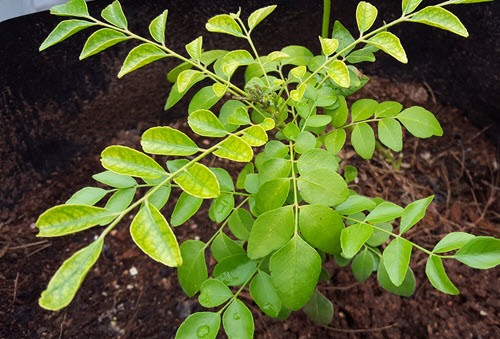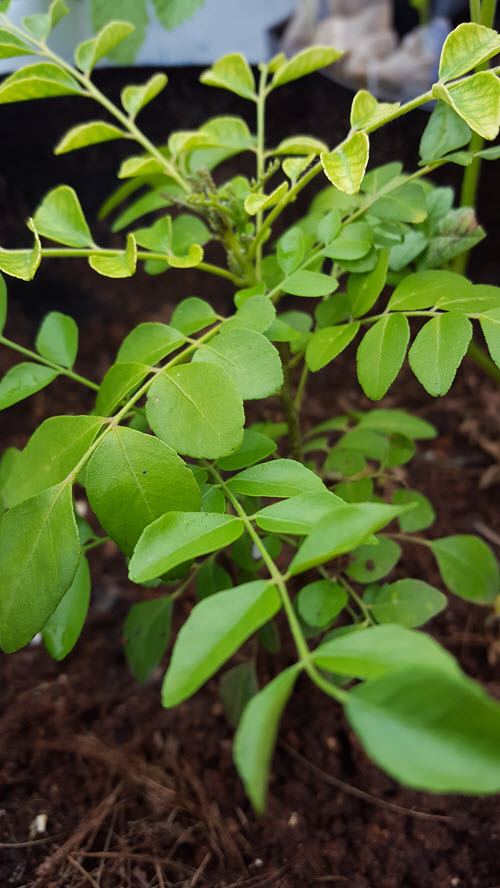Curry leaf plants are native to India and grows to a height of about 5-6 meters. The elongated green, shiny leaves add a distinct aroma and flavor to many Indian dishes. There are 3 varieties of curry leaf plants; the regular variety that you find in supermarkets grows tall quickly but has less fragrance. The dwarf variety is short with longer leaves and the Gamti variety grows ever so slowly, has thick short leaves and is highly fragrant. In this post, we take a look at how to grow curry leaf plants at home in containers and care for them.
How to Grow a Curry Leaf Plant

The curry leaf plant grows well in full to partial sunlight, but it can also be grown in a balcony where you get direct sunlight for a few good hours. It requires a slightly acidic soil that is well drained with a good mix of cow dung/compost and river sand for good growth. The best times for growing the plant is during the months of February to March.
The curry leaf plant can be grown from seeds or from stem cuttings. If you grow the plant from a seed, it will take between 1-2 years before you actually start to see steady growth. Buying a curry leaf plant from a nursery is way better as you can reap the benefits faster. In general, the curry leaf plant is a slow grower reaching a height of about 6 inches a year, so be patient and wait it out.
How To Grow Curry Leaves from Seeds
Propagation from cuttings is the easiest way to grow curry leaf plant.
1. Pick the berries from the curry leaf plant when they are black. That’s the time they are the ripest.
2. You can sow it as is, but germination may take longer. Instead, squeeze out the seed from the ripened berry and place them in a moist paper towel for a couple of days before sowing. This will speed up germination.
3. Place the seeds and inch below the soil, cover them up and place in a warm place. The seeds should germinate in about 10 days.
How To Grow Curry Leaf Plants from Stems
1. Prepare your potting mix with 1 part sand, 1 part compost and water it well.
2. Find a branch from the curry leaf plant that is pencil thick, not too flexible or too stiff. Slant cut the branch that is about 5 inches long with about 4-5 leaf stems.
3. Remove the last couple of leaf stems and place the cut end into the soil.
4. Firm the soil around the cut branch and don’t water it again.
5. You can place a polythene bag over the pot, tie the top end, and keep it in the shade for about 10 days. The cutting will start giving out new shoots in about 10 days.
6. Continue to keep the pot in the shade for a few more weeks until the plant looks firmer and stronger.
Curry Leaf Plants Growing Tips

1. Do not over-fertilize young plants. If you must add fertilizers apply them to the rim of the pot.
2. Once established, you can apply a liquid seaweed fertilizer every 3 weeks for leafy growth. Diluted curd or buttermilk is as excellent home fertilizer for the curry leaf plant.
3. Allow the soil to dry completely before watering. In winter, the plant becomes dormant, so apply less water during the time.
4. Young curry leaf plants do not like the direct summer sun nor do they prefer a wet soil. So you need to take extra care with them when they are young.
5. You can nip off the tips of the branches to encourage the plant to product lateral branches, which will give more leaves.
6. Pluck the flowers and buds when they appear on the branches as they will suck up the energy needed for leaf production.
7. You’ll need a big pot to grow the plant as transplanting them later to a bigger pot won’t be an easy job. The roots of the plant don’t like to be disturbed, so you need to make sure to move them with the soil during transplantation.
8. The curry leaf plant is normally not affected by pests or diseases.
Medicinal Uses of Curry Leaf
The Curry Leaf plant has several medicinal benefits associated with it, according to traditional uses and some scientific research. Here are a few:
- Digestive Health: Curry leaves are often used in Ayurveda to improve digestion and alter gut bacteria positively.
- Antioxidant Properties: Curry leaves contain several antioxidants that may help the body remove harmful free radicals.
- Anti-Diabetic Effects: Some research suggests that curry leaves could benefit people with high blood sugar levels, possibly due to compounds that can affect carbohydrate metabolism.
- Cholesterol Regulation: Certain components in curry leaves are believed to help control cholesterol levels.
- Hair Health: Curry leaves are popularly used in hair care remedies, believed to prevent premature graying and promote hair growth.
- Liver Protection: Some animal research indicates that curry leaves may protect the liver from oxidative stress and harmful toxins.
So grow a curry leaf plant in your home garden and enjoy all the benefits it has to offer.
If you have any further questions about growing the popular curry leaf plant in your garden, please reach out to us in the comments section.
Meanwhile feel free to check out these plants on the Amazon Store!
Very useful and informative write-up on curry leaf plant. I understand from your write-up that Gamti variety is the most fragrant. Is there any way you can help me get two plants of the Gamti variety, please. Thank you. I had a six year old ordinary curry leaf tree which got dried up one month ago for reasons unknown to me. I am writing from Cochin/Kochi, Kerala.
Very helpful information. Thanks
My ladies patta plant is the gamti variety and grows ever so slowly. It has black spots on the leaves which when wiped is powdery . I have tried using neem oil as well as cake to get rid of it but it keeps returning. Can somebody tell me how to treat this.
i need gamathi variety curry leaf plant, please help me to get one plant.